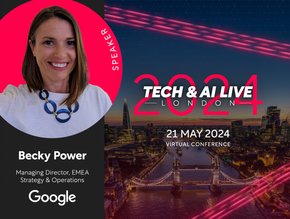Fighting the Great Resignation with predictive analytics

COVID-19, and the subsequent restrictions that came with it, caused a number of people to reassess what is important and question if they are happy in their role. In the wake of the pandemic, many organisations are now grappling with issues around staff retention, particularly as the Great Resignation manifests itself in workplaces across industries.
Many prospective employees are now looking for greater flexibility affording them a better work-life balance. To respond to the changing needs, businesses and leaders are responsible for identifying ways to incentivise potential employees to not just join their teams, but to remain in them long-term.
“Businesses must accommodate increasingly varied, complicated employee needs, integrating hybrid working to draw on the benefits of both physical and virtual workspaces,” comments Eliane Lugassy, CEO and Co-Founder of Witco, an app provider enabling the most ideal work experience, enabling people to perform at their best.
The Great Resignation has created a healthy employee market with a wealth of opportunities, meaning employers have to be more creative if they want to attract the right talent. Predictive analytics may be the key to overcoming challenges faced by employers as they look to onboard new team members.
“Leaders cannot adequately understand the needs of present and future employees without data and the communication tools to act on it,” explains Lugassy.
“Communication breakdowns through lockdown reminded us that, for hybrid working models to work, we must make the most of the time we have together in the office and respond as appropriately as we can to a remote team in order to keep them onside. If we are to do this successfully, we must use technology to understand and respond to changing workspaces,” she adds.
Creating stronger employee retention with predictive analytics
With the ability to model resignation trends, predictive analysis can lead to a stronger employee retention strategy by providing employers with deeper insight derived from different data sources.
“Machine learning will allow businesses to analyse the information they gather from surveys and meetings with employees. Predictive analytics will measure and adapt the physical workspace to deliver an optimum environment for productivity regardless of how complicated working patterns become. This might mean monitoring which days are busiest to help coordinate employees for collaborative work. It might also mean modelling resignation trends to pinpoint a common source of discomfort in the workplace,” says Lugassy.
Technology is being applied in all subsections of business; now more than ever, it is crucial for it to be utilised in HR as part of the overall digital transformation strategy, as Lugassy outlines: “Mining data about current office use will inform how we prepare for the office of the future. Digital transformation has familiarised businesses in almost every sector with the power of technology to foster a transparent, collaborative working environment.”
“In a volatile and uncertain business landscape, predictive analytics will be key to ensuring that companies and their employees are aligned ‒ both now and in the future,” she continues.
Creating the right IT system for data
The Great Resignation was a term initially coined in the US, marking the period between April 2021 and present day where the share of nonfarm workers quitting their jobs has been at some of the highest levels recorded by the American bureau. In all, nearly 33 million people have left their positions over this period, or over a fifth of the total U.S. workforce.
A vital hurdle to overcome in the Great Resignation is an unconnected and incompatible IT system, as Chris Norton, who is Managing Director, InterSystems UK and Ireland, a software company for database management, explains: “The first step in tackling this is bridging data from disparate data sources, allowing better business value while enabling them to obtain new insights and better business decisions.”
An enterprise data fabric, a new architectural approach, speeds up and simplifies access to data assets across the entire business, providing consistency across a choice of endpoints spanning hybrid multi-cloud environments.
It accesses, transforms and harmonises data from multiple sources, on-demand, to make it usable and actionable for a wide variety of business applications.
“Simplifying their data architecture by implementing a smart data fabric can provide organisations with a single, unified, and on-demand view of data, enabling businesses to gain an enterprise view of what is happening in real-time, ensuring decisions are based on timely and trustworthy data,” comments Norton.
He adds: “Adopting a smart data fabric approach to data management sets the wheels in motion for an organisation's digital transformations, providing them with comprehensive, accurate, and timely information to make informed decisions and develop new initiatives”, which could be key in attracting new talent.
Changing data collection strategies for improved insight
As more people reflect on their lives and reassess their careers, it is more critical than ever that employers make the right decisions as they look to deliver fulfilling workplace experiences to retain and hire talent.
Commenting on this, Phil Pringle, Employee Experience Strategist at Qualtrics, an experience management company, explains: “Organisations need to embed modern listening strategies to gather insights that reveal what employees are thinking and feeling to inform the action they take, as opposed to just running traditional pulse surveys that only offer surface-level scores on employee engagement.”
One key way to gather more insights is to change the ways employers obtain information from their employees, especially as some are more comfortable with directly voicing their opinions than others. By switching up their strategies, businesses may gain more insight and data to create more reliable analyses.
“They need to go beyond annual pulse surveys or collecting operational data from IT around things like service usage, average handle time, and first-call resolution. Instead, employers need to get smart in the way they collect, understand, and act on experience data (X-data). X-data provides insight into mindset and sentiment, by looking deeper at things like emotion and emotional intensity, to paint a more complete picture of the employee experience,” outlines Pringle.
He concludes: “This practice assesses the entire employee journey — going all the way from the candidate’s hiring and onboarding experience to their exit interview. With experience data, employers can gain a better understanding of what people are experiencing day-to-day and what changes need to happen to create ideal working environments where people feel connected, able to perform, and can develop their career. It’s X-data that ultimately equips business leaders with the insight they need to stem the Great Resignation.”






